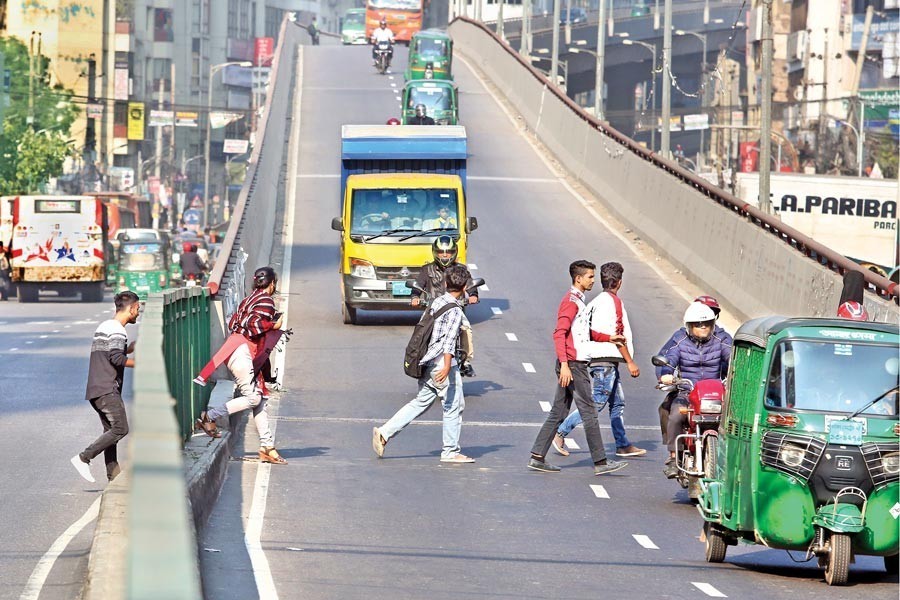
Published :
Updated :

Amid the unabated road accidents across the country, few are inclined to muster up the patience to remember the days-long street demonstrations in 2018 by students to press the demand for safe roads. Except for a few months' relief, the Dhaka roads went back again to their earlier anarchic and unruly state. In just a year, accident-prompted deaths started ruling the roost. Roads and highways have yet to be free of terrible accidents, many being fatal. It seems the spontaneous protests in 2018 had little impact on the reckless transport operators.
The reason people not interested to recall the heady days is the lack of effective action in ensuring safe roads by the relevant authorities --- as had been promised. Both the students and members of the public are disillusioned, so are the victims' relatives and the road safety activists. Everybody seems to be blasé and is overtaken by despondency when it comes to the state of road safety in the country, especially in Dhaka. Against this backdrop, an FE report has quoted a passenger welfare platform as having said that road accidents killed 39,522 people in the country in the last five years. The reason cited was the government's promise for safer roads had not yet been materialised. The passenger welfare group titled Bangladesh Jatri Kalyan Samity (BJKS) carried out the survey showing at least 28, 299 road accidents had taken place since the year of 2018, in which 58,791 people were injured. Appallingly, of the injured 3, 941 were students. The passenger welfare platform presented an in-depth analysis of its survey at a programme in the capital recently. It marked the 5th anniversary of the students' movement for safe roads after the barbaric killing of two college students by a speeding bus.
Dwelling at length on the prevailing situation on road safety, the general secretary of BJKS has said the present government promised safe roads after the largest student movement in the country's history in 2018. The authorities were capable of realising that the time was highly volatile. Mostly in order to pacify the students reeling from the shock of the death of the two students, the government accepted all the demands of the safe road activists. Unfortunately, few of them had been implemented, the BJKS general secretary observed with a note of despair.
Roads have long been back to their earlier chaotic state. Nowadays, hardly a day passes that doesn't see a terrible road accident occurring on a road in Dhaka, or a national or regional highway elsewhere in the country.
It's worth mentioning that the report of a new analysis published in the media on August 6 says as many as 576 people were killed and 1055 injured in road accidents across the country in last July. The study further says among the vehicles involved in the accidents were 18.74 per cent buses, 22. 84 per cent pick-up vans, covered vans and lorries, 6.83 per cent private cars, jeeps and microbuses, 5.74 per cent CNG-run auto-rickshaws, 25.99 per cent motorbikes, 15.32 per cent battery-run human haulers and 4.51 per cent three-wheelers. Surprisingly, among those killed in road accidents in July, 119 were drivers. Despite the fact that the latest tally presents the view of a single month, in terms of severity it is no less frightful than that of the five years. The inevitable conclusion, thus, is one of continued deterioration in the road traffic scenario.
In a general view, apart from the dreadful traffic gridlocks caused by flouting of rules, reckless driving has staged a full-scale comeback. As has been seen before, plying of unfit vehicles continues unabated. Those include ramshackle and improvised vehicles, easy-bikes and battery-powered rickshaws. In the last five years after the students' demonstration, the road traffic authorities have picked the trend of giving the impression that accidents are decreasing. It's true the incidence of road accidents came down noticeably after the road safety movement. But there are reservations. As has been learnt, the new Road Transport Act 2018 was passed hastily in the face of the students' pressure to realise their demands. But due to various kinds of conditions imposed by the transport owners and the powerful drivers' unions, the new Act that emerged was veritably the old one. It could be seen in the obstinate dominance of anarchy that prevails on the country's roads and highways these days.
The spectacles of competition between speeding buses to pick more passengers, ride-sharing motorbikes' tendency to overtake one another, the compulsive nature of jaywalking and other irregularities continue to worsen. The highways have long become synonymous with disorderliness of all conceivable kinds.
The movement pressing the demand for safe roads appeared to have prompted the different traffic authorities and policy makers to bring the country's roads and highway traffic under a semblance of sharp scrutiny. Following the narrow escape from an imbroglio, the traffic lawmen were found eager to enforce road disciplines stringently. The measure didn't fail to see the desired result. Roads without major accidents and the habitual tendency to break law remained in place for months. The seemingly overhauled situation has prevailed for some time thanks to the sharp vigilance of the authorities, the media and the civil society. But as has been seen in many other sectors, all fresh initiatives eventually get back to square one. Here lies the tragedy.


 For all latest news, follow The Financial Express Google News channel.
For all latest news, follow The Financial Express Google News channel.